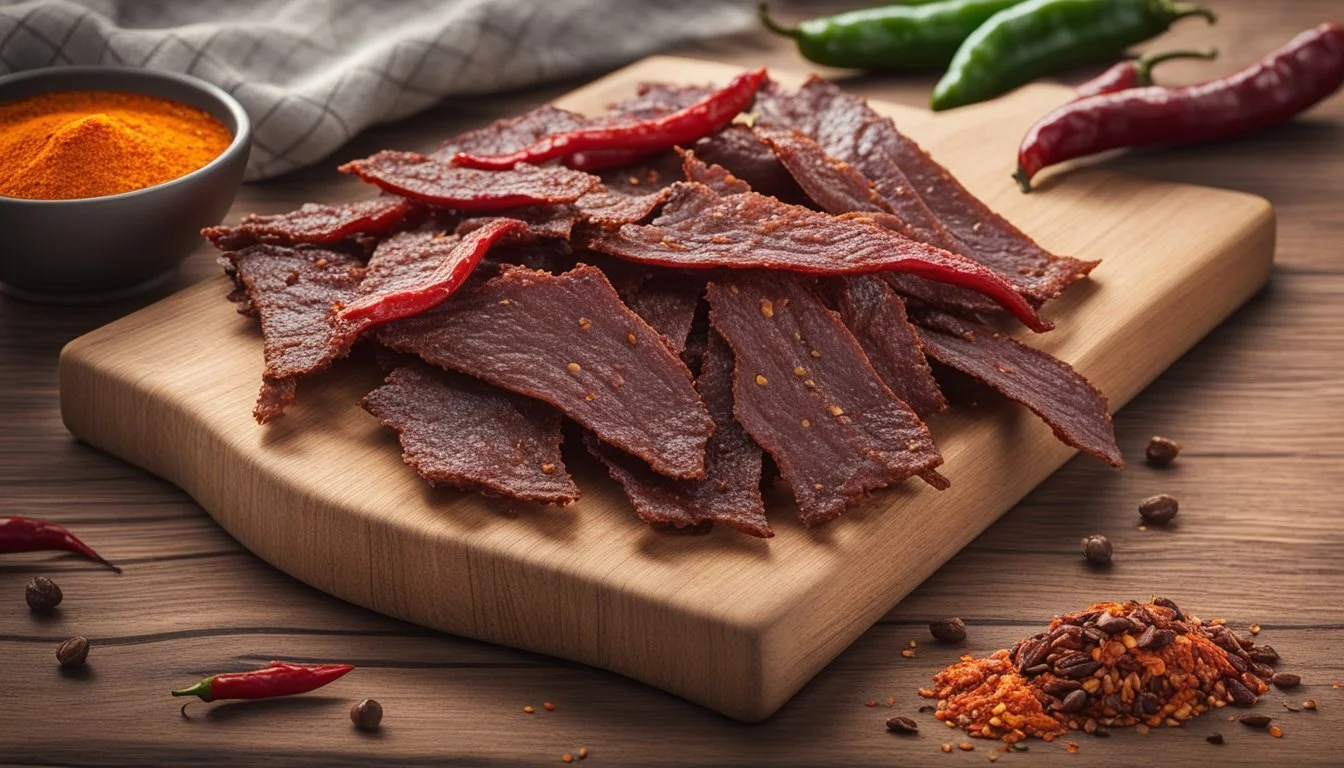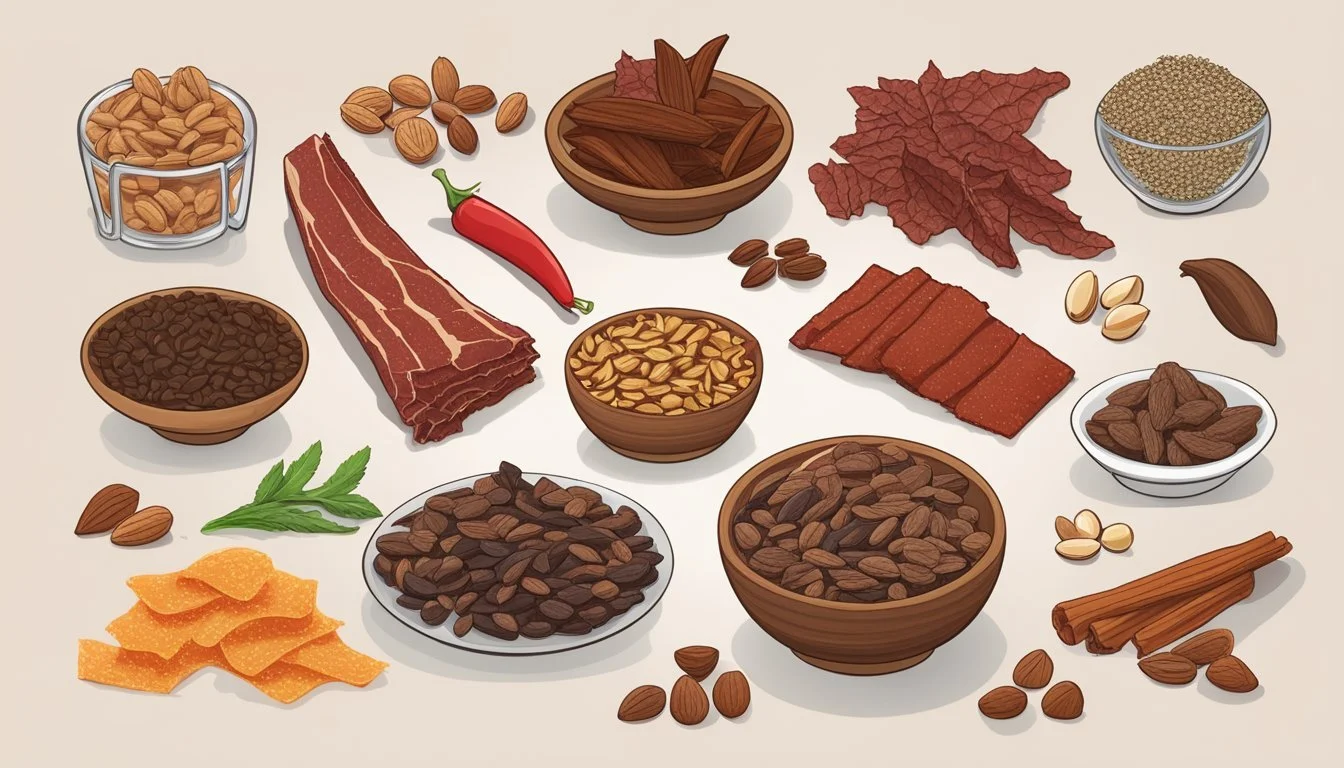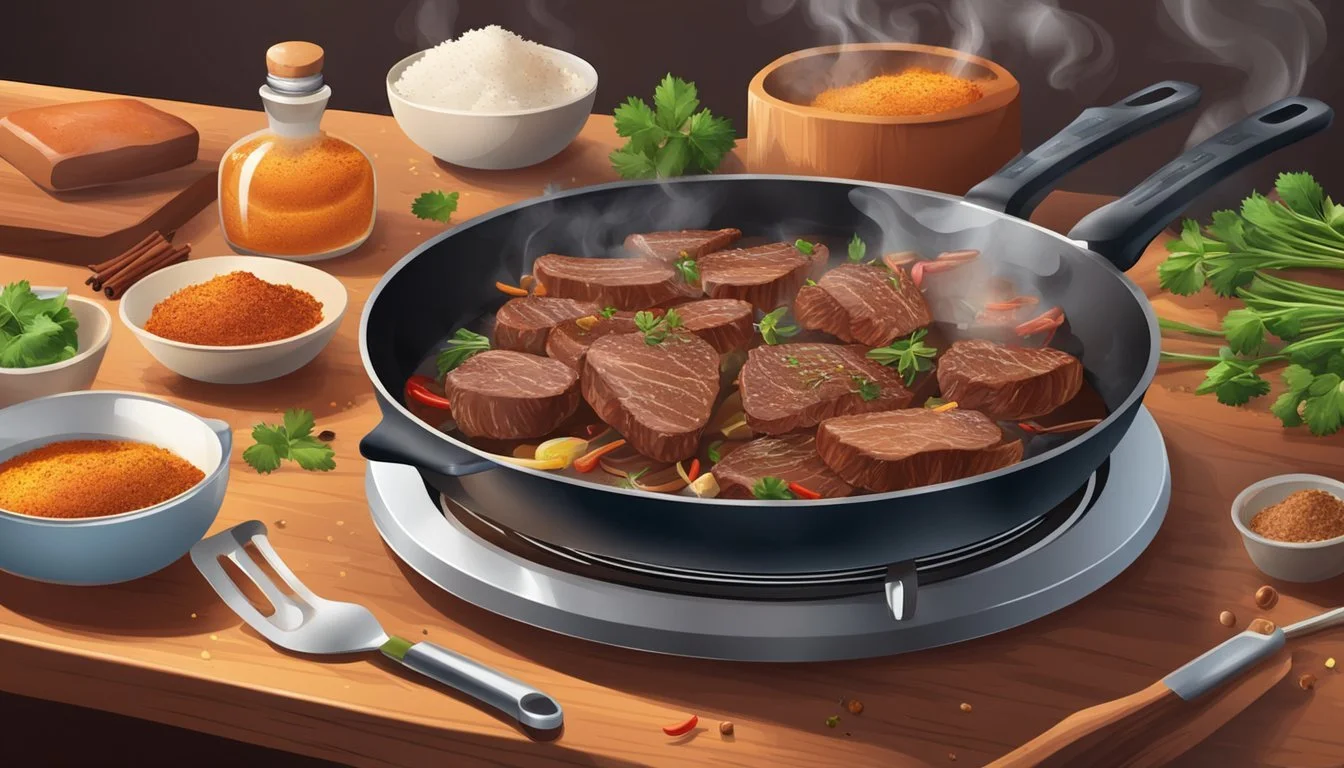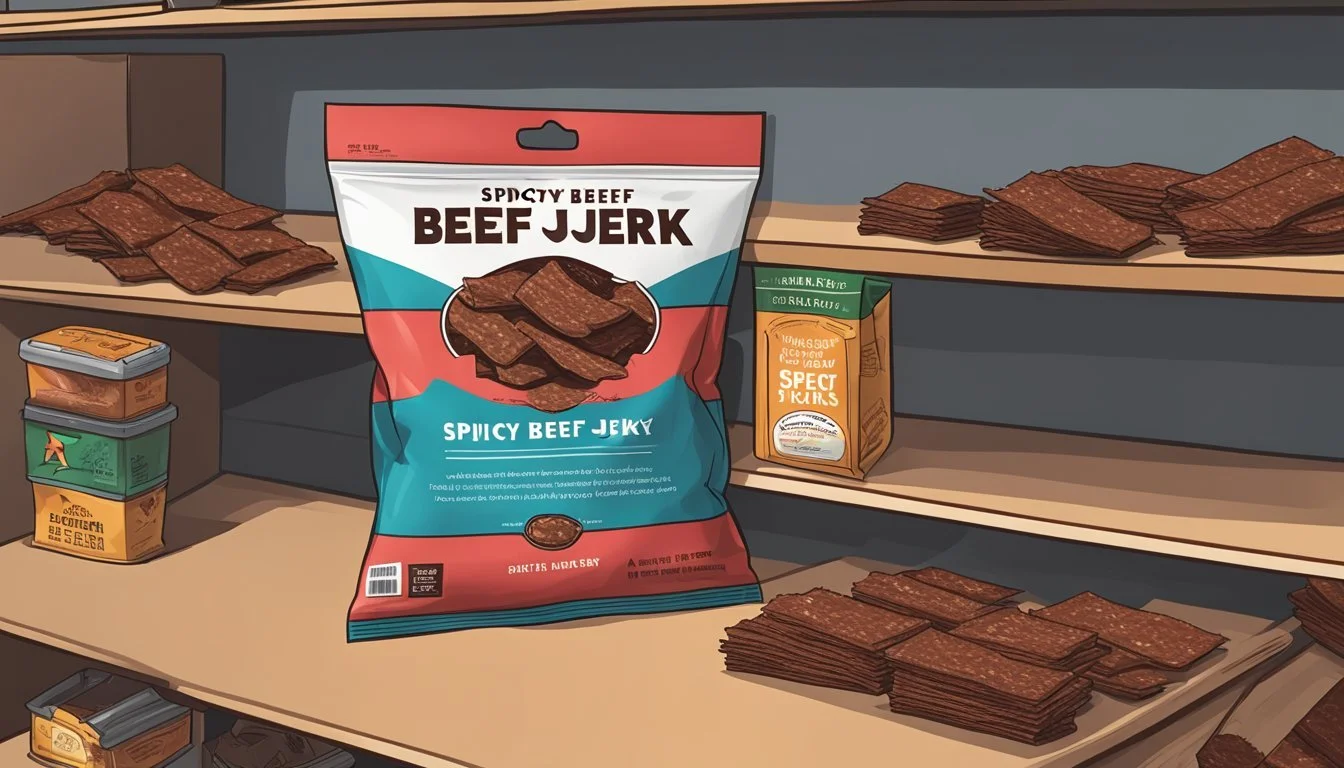The Spiciest Beef Jerky
A Guide to High-Protein, Low-Carb Snacking
Beef jerky has long been a favored snack for those seeking a savory treat that's both high in protein and low in carbohydrates. Its convenience and longevity have made it a staple in the diets of fitness enthusiasts, hikers, and anyone looking for a nutritious snack on the go. Amidst the vast range of flavors available in the market, the spiciest variants of beef jerky stand out for their bold taste and fiery kick.
For those who relish heat, spicy beef jerky offers a unique blend of the traditional jerky's meaty satisfaction paired with the intense flavors of various chilies and spices. This combination not only satiates the palate but also provides the dietary benefits of a snack that is usually made from lean cuts of beef, making it inherently low in fat. The dehydration process preserves the meat while concentrating its flavor and nutrients, resulting in a snack that is rich in protein, crucial for muscle repair and growth.
Spicy beef jerky fits well into various dietary regimens, particularly keto and other low-carb diets, due to its minimal carbohydrate content. The heat factor, contributed by ingredients like habaneros, cayenne, or ghost peppers, offers an additional metabolic boost for some, as capsaicin—the compound responsible for the burning sensation of hot peppers—has been associated with increased calorie burning. This makes the spiciest beef jerky a tempting option for those looking to maintain a high-protein diet without sacrificing flavor.
Nutritional Profile of Beef Jerky
Beef jerky is a nutrient-dense snack that provides a high-protein, low-carb option satisfying for those on diets such as keto. It's made by drying lean cuts of beef, resulting in a concentrated source of nutrients.
Macronutrient Breakdown
Protein: Beef jerky is protein-rich, with about 9.4 grams per ounce, making it an excellent snack for muscle repair and satiety.
Total Fat: Moderate, contains about 7.3 grams per ounce with some brands offering varieties rich in omega-3 fatty acids.
Carbohydrates: Low, generally ranging around 3.1 grams per ounce with minimal sugars.
Calories: One ounce provides roughly 116 calories, making it a calorie-efficient protein source.
Vitamins and Minerals
Iron: Beef jerky is a good source of iron, which is essential for carrying oxygen in the blood.
Vitamins: It can also contain vitamins such as B12 and niacin, supporting energy metabolism.
Minerals: Contains minerals like zinc and phosphorus, and some varieties are fortified with additional nutrients.
Health Benefits of High-Protein Snacks
Satiety: High-protein snacks like beef jerky can provide greater satiety, helping control appetite.
Ketogenic Friendly: The low-carb profile of beef jerky fits well within a ketogenic dietary regimen.
Nutritional Value: Beef jerky's nutritional profile supports muscle maintenance and overall health when consumed as part of a balanced diet.
Choosing Quality Ingredients
When selecting ingredients for the spiciest beef jerky, it's essential to focus on the quality of the beef and the flavorings used. High-quality ingredients not only ensure a richer taste but also provide a healthier snacking option.
Grass-Fed Beef Selection
For the base of beef jerky, grass-fed beef is superior. Grass-fed cattle are not only raised on a natural diet of grass but also tend to contain more omega-3 fatty acids and antioxidants compared to grain-fed counterparts. Grass-fed beef as a starting point promises a purer, more robust beef flavor that is essential for making standout spicy beef jerky.
Natural Spices and Flavorings
Spices and natural flavorings are the heart of any spicy beef jerky. A well-balanced blend of garlic powder, onion powder, black pepper, and sea salt can elevate the jerky's taste. For heat, ingredients like crushed red pepper or specific chili powders add a significant kick. Moreover, opting for all-natural or organic spices, free from artificial additives, maintains the jerky's integrity and ensures the snack is both healthy and flavorful.
Importance of Organic and Non-GMO
The commitment to organic and non-GMO ingredients reflects a dedication to health and sustainability. Using organic spices and flavorings such as coconut aminos — a natural soy sauce alternative — implies no synthetic pesticides or genetically modified organisms are involved. Choosing these better-for-you options results in a beef jerky that is both safe to consume and environmentally responsible.
Spice Blends for Beef Jerky
In crafting the ultimate spicy beef jerky, the right blend of spices can elevate the snack from merely hot to a complex, mouthwatering experience. This section provides specific guidance on creating a spice mix that delivers on heat without compromising flavor.
Creating the Spiciest Mix
When aiming for maximum spiciness, habanero pepper takes center stage, known for its intense heat complemented by a fruity undertone. For a well-rounded spicy mix, a foundation of garlic powder and onion powder lays the groundwork, while granules of black pepper can add a sharp bite. The combination of these spices creates a powerful heat profile that satisfies those craving the spiciest jerky.
Habanero Pepper
Garlic Powder
Onion Powder
Black Pepper
Balancing Flavors with Heat
High heat doesn't mean sacrificing flavor. To balance the fiery kick, adding smoked paprika not only provides a gentle sweetness but also introduces a smoky essence, reminiscent of traditionally smoked meats (What wine goes well with smoked meats?). It’s essential to include paprika for its subtle earthiness and to help the blend adhere to the beef jerky, offering a vibrant color and milder heat.
Smoked Paprika
Paprika
Combining these spices thoughtfully ensures that each bite of beef jerky is not only fiercely spicy but also rich in flavor, leaving an unforgettable impression on the palate.
Low-Carb and Keto-Friendly Snacking
For those following a ketogenic diet or simply aiming for a low-carb lifestyle, selecting the right snacks is crucial for maintaining their nutritional goals. High-protein, low-carb snacks like beef jerky can be a smart choice, provided they contain minimal net carbs and align with keto principles.
Understanding Net Carbs
Net carbs are calculated by taking the total carbohydrates in a food and subtracting the fiber and certain sugar alcohols, which have a negligible effect on blood sugar levels. This number is particularly important for individuals on a keto diet, as it impacts ketosis, a metabolic state where the body burns fat for fuel instead of carbohydrates.
To calculate net carbs for a snack such as beef jerky:
Total Carbohydrates - (Dietary Fiber + Sugar Alcohols) = Net Carbs
When selecting beef jerky, it's essential to choose an option that has been seasoned without added sugars, as these can significantly increase the net carbs and potentially interrupt ketosis.
Keto Diet Compatibility
The ketogenic diet emphasizes the consumption of foods high in healthy fats and proteins while limiting carbohydrates. Beef jerky, when minimally processed and free from high-carb additives, is a keto-friendly snack option.
A few points to remember about beef jerky in relation to the keto diet include:
Low-Carb: Look for products or recipes specifically labeled as low-carb to ensure they fit within the typical keto daily limit of fewer than 50 grams of total carbs.
Protein-Packed: Beef jerky provides a substantial amount of protein, helping to satisfy hunger and support muscle maintenance, which is beneficial for those aiming to achieve or sustain ketosis.
Snack Convenience: Its portability makes it an easy, on-the-go snack option for those who need a quick source of energy that aligns with their dietary restrictions.
For the best results, consumers should opt for beef jerky that lists the net carbs per serving, confirming that the product is conducive to their keto lifestyle.
Preparation: From Slicing to Dehydrating
Creating the spiciest beef jerky involves precise slicing, a dynamic marinade, and careful dehydrating techniques. This section details the steps necessary to craft a high-protein, low-carb snack with an emphasis on lean cuts of beef and bold flavorings, minimizing preservatives in favor of natural preservation methods.
The Art of Slicing Meat
To ensure uniform drying and texture, one must begin with the proper slicing of the meat. The ideal cuts for jerky are lean with minimal fat, such as flank steak or top round. These cuts should be partially frozen to facilitate the slicing process. Thin strips, about 1/4-inch thick, can either be cut with or against the grain; against the grain for tender jerky or with the grain for a chewier texture.
Marinating for Flavor and Tenderization
The marinade is crucial for infusing the beef with spicy, intense flavors and tenderizing it. A well-crafted marinade might include ingredients like hot peppers, vinegar, and Worcestershire sauce, though one can tailor the recipe to personal heat preferences. After thoroughly coating the beef strips, they should rest in a refrigerator for a minimum of 30 minutes to 24 hours. The longer the meat is marinated, the more pronounced the flavor will be.
Dehydrating for Preservation
Dehydrating is the final step to achieve preservation without the need for artificial preservatives. The marinated beef strips are laid out on dehydrator racks or oven racks covered with parchment paper, ensuring they do not overlap. Using a dehydrator or oven set to 160°F (71°C), the beef is dehydrated for 4-6 hours. The jerky is done when it is dry but still pliable, indicating proper moisture removal for long-term storage.
Homemade Vs. Store-Bought Jerky
When selecting spicy beef jerky, consumers often weigh the benefits of homemade jerky against the convenience of store-bought varieties. The primary considerations revolve around the control of ingredients, particularly additives and preservatives, and the nutritional edge that can be achieved through the homemade process.
Benefits of Making Beef Jerky at Home
Homemade beef jerky offers several advantages. Primarily, it allows the maker to select high-quality, lean cuts of meat, ensuring a low-fat, high-protein snack. Moreover, individuals can adjust the level of spiciness to their preference and can opt for all-natural ingredients without the addition of artificial flavors or colors. This DIY approach also circumvents the common use of nitrates or nitrites which are typically found in commercial jerky as preservatives.
Control Over Ingredients: Use of all-natural spices and homemade marinades.
Nutritional Profile: Typically lower in fat and calories compared to commercial options.
Comparing Additives and Preservatives
The divide between homemade and store-bought beef jerky is evident in their respective ingredient lists. Store-bought jerky often includes additives like monosodium glutamate (MSG) and additional preservatives to extend shelf life. These may include but are not limited to sodium nitrate or sodium nitrite. Homemade jerky, while fresher, often relies heavily on salt for preservation but can avoid the use of artificial preservatives, leaning into a more all-natural recipe.
Store-Bought: May contain artificial preservatives (nitrates or nitrites), MSG, and additional additives for flavor and longevity.
Homemade: Typically uses salt as a preservative and avoids synthetic additives.
Cooking Methods
When crafting the spiciest beef jerky, selecting the right cooking method is crucial to achieving the ideal texture and flavor. Three popular techniques are employed to remove moisture and preserve the jerky: oven baking, smoking techniques, and using a food dehydrator. Each method brings its unique characteristics to the jerky.
Oven Baking
Baking beef jerky in an oven is an accessible option that requires no special equipment aside from a wire rack. Initially, one preheats the oven to a low temperature, typically around 175°F (80°C), to prevent the meat from cooking too quickly. The beef strips are placed on a wire rack set over a baking sheet, allowing for airflow and moisture to escape. This method generally takes a few hours, during which the strips should be observed and flipped occasionally to ensure even drying.
Smoking Techniques
Utilizing a smoker infuses the jerky with a distinctive smoky flavor. Smokers are ideal for the task due to their ability to sustain low temperatures and smoke generation, which adds another layer of taste to the jerky. To smoke jerky:
Preheat the smoker to 165°F (74°C).
Arrange the meat on the smoker's racks, ensuring that the pieces do not overlap.
Allow the beef to smoke for about 6 hours, though the actual duration may vary with the meat's thickness and the smoker's specifics.
One should keep in mind that while smokers are excellent for flavor, they are less portable than other methods.
Using a Food Dehydrator
For those specifically after a low-moisture content, a food dehydrator is the most efficient and consistent method. Dehydrators are designed to evenly circulate air and maintain the low heat necessary for drying jerky without cooking it. To dehydrate jerky:
Arrange the seasoned beef strips in a single layer on the dehydrator trays.
Set the dehydrator to the recommended temperature for meat, generally around 160°F (71°C).
The dehydration process can take between 4 to 8 hours, depending on the desired dryness.
Food dehydrators are convenient and portable options, making them a popular choice for homemade beef jerky enthusiasts.
Dietary Considerations
When selecting the spiciest beef jerky, consumers must consider potential dietary restrictions and preferences. The snack's compatibility with various diets and the presence of allergens or sensitive ingredients are key considerations.
Allergies and Sensitivities
Gluten-Free: Most beef jerkies are inherently gluten-free as they primarily consist of meat and spices. However, one should always verify that the spice blend does not include any wheat-based additives or cross-contamination has not occurred if they are sensitive to gluten.
Nuts and Seeds: Spicy beef jerky typically does not contain nuts or seeds, but those with allergies to these ingredients should check labels carefully, as some spice blends might include them for added flavor or texture.
Eggs: Eggs are not a standard ingredient in beef jerky, so those with egg allergies can generally consume this snack without concern.
Paleo: Beef jerky aligns well with the Paleo diet if made without preservatives or added sugars, focusing on high-quality animal products and natural spices.
Meat Alternatives for Jerky
For those seeking alternative protein sources, jerky can be made from turkey, pork, or chicken. These meats serve as viable options and adhere to the high-protein, low-carb profile, though their nutritional content may vary slightly from beef. Pork jerky, for example, will have a different fat content compared to beef, and turkey jerky is often leaner, providing a lower fat option for those monitoring their intake.
Beef Jerky in a Balanced Diet
Beef jerky, known for its high protein content and low-carb profile, presents itself as a powerful snack in a balanced diet when consumed with consideration for portion size and nutritional balance.
Portion Control and Moderation
When integrating beef jerky into one's diet, registered dietitians often emphasize the importance of portion control. Given that jerky is a protein-rich snack, it's easy to overconsume, which could lead to excessive sodium intake.
Recommended Serving: 1 ounce of beef jerky
Protein Content: Typically between 9-14 grams per serving
In moderation, jerky's protein can sustain energy and aid in muscle repair, making it an ideal, low-carb snack post-exercise.
Incorporating Jerky into Meals and Snacks
To avoid excessive sodium and additives common in many jerky products, one should look for options with lower sodium and no added sugar.
As a Snack: Pair with a source of carbohydrates, such as an apple, for balanced nutrition.
In Meals: Add to salads or wraps for a high protein boost without the need for cooking.
Incorporating jerky into one's diet should be done thoughtfully, ensuring that it complements a variety of nutrients rather than displacing other vital food groups.
Safety and Storage Tips
When dealing with spicy beef jerky, safety and proper storage are paramount to maintain its quality and prevent spoilage. Preservatives in jerky, such as salt and nitrates, help to inhibit bacterial growth, but correct storage is still essential.
Refrigeration is not necessary for sealed, commercially-prepared beef jerky due to its low moisture content and the presence of preservatives. However, once opened, placing the jerky in the refrigerator will extend its freshness. Consumers should consume refrigerated jerky within one to two weeks for optimal quality.
For homemade beef jerky, which may lack commercial preservatives, storing in the refrigerator is advised, particularly if it's consumed gradually. Employing airtight containers or vacuum-sealing homemade jerky can protect it against moisture and contaminants, extending its shelf life.
Here are concise storage tips for beef jerky:
Unopened Jerky:
Store in a cool, dry place away from direct sunlight.
Check the expiration date for shelf life—typically 1 to 2 years.
Opened Jerky:
Keep in the refrigerator in an airtight container.
Consume within one to two weeks.
Homemade Jerky:
Refrigerate in an airtight container or vacuum-sealed bag.
Consume within two to three months, check frequently for signs of spoilage.
Avoid containers that are not sealed properly, as this can allow moisture and bacteria to affect the jerky. Always inspect jerky for off odors, discoloration, or mold before consumption, as these can be signs of contamination. Remember that storage times can vary, so regularly check your jerky to ensure it remains safe to eat.
The Future of Jerky Products
The jerky market is evolving, with significant advancements in flavor profiles and nutritional benefits, matched by a growing commitment to sustainability in production practices.
Innovations in Flavor and Nutrition
Consumers' palates have become more adventurous, and manufacturers are responding with bold, innovative flavors ranging from sweet and tangy to fiery hot. Brands like The New Primal are introducing products that cater to these diverse tastes while also prioritizing health by using organic and grass-fed beef. These efforts result in jerky that not only satisfies cravings but also offers enhanced nutritional value. For instance:
Flavors: Habanero Pineapple, Thai Chili, Chipotle Honey.
Nutritional Highlights:
Lean protein: Jerky provides a high-protein snack, essential for muscle maintenance.
Low carbohydrates: Ideal for those following a low-carb diet.
Grass-fed: Beef used in these products comes from cattle that have a diet natural to their digestive systems.
Sustainable Production Practices
The jerky industry has taken strides in adopting more sustainable production practices, understanding that consumers are increasingly concerned with environmental impact. Some key aspects include:
Sustainable Sources:
Grass-fed beef: Utilized for its lower environmental footprint compared to grain-fed counterparts.
Organic ingredients: Lessen the use of harmful pesticides and chemicals in production.
Eco-friendly Packaging:
Innovations in packaging aim to reduce plastic usage and increase the recyclability of materials.
By integrating these practices, jerky producers not only enhance the nutritional profile and taste of their products but also contribute positively to the planet, meeting consumer demands for ethical and sustainable snacking options.











